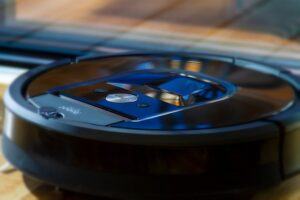Are robot vacuums really effective at keeping your floors clean? Do they have enough suction power to tackle different types of debris? These are the questions that often come to mind when considering investing in a robot vacuum. In this blog post, we will delve into the world of robot vacuums and explore the suction capabilities of these innovative cleaning devices.
We’ll discuss the technology behind robot vacuums and how it impacts their suction power. You’ll learn about the different factors that determine suction strength and how they vary among various robot vacuum models. We’ll also explore the real-world performance of robot vacuums and whether they can effectively clean different floor types and surfaces.
Furthermore, we’ll address common concerns such as whether robot vacuums can handle pet hair, fine dust, and larger debris. By the end of this post, you’ll have a comprehensive understanding of whether robot vacuums truly have good suction and whether they are a worthwhile addition to your cleaning arsenal. So, let’s dive in and uncover the truth about the suction capabilities of robot vacuums!
How Does Suction Power Affect a Robot Vacuum’s Performance?
Suction power is a critical factor in determining the cleaning efficiency of a robot vacuum. It directly influences the vacuum’s ability to lift dirt, debris, and pet hair from various surfaces. A robot vacuum with higher suction power can more effectively capture and remove dirt and allergens from your floors, ensuring a cleaner living environment.
In addition to the suction power, the design of the vacuum’s brush rolls and the efficiency of its filtration system also play a significant role in its overall performance. The brush rolls agitate and loosen dirt, allowing the suction to effectively remove it, while the filtration system ensures that the captured particles are retained within the vacuum and not released back into the air.
The suction power of a robot vacuum is typically measured in terms of air watts, which indicates the amount of air moved through the vacuum to pick up debris. Higher air watts generally translate to stronger suction, enabling the vacuum to pick up more dirt and debris in a single pass. It’s important to note that while suction power is essential, other factors such as the vacuum’s navigation capabilities and battery life also contribute to its overall performance.
Factors to Consider When Evaluating a Robot Vacuum’s Suction Power
When evaluating a robot vacuum’s suction power, it’s essential to consider several key factors that can impact its cleaning performance. Suction power plays a crucial role in how effectively a robot vacuum can pick up dirt, dust, and debris from various floor surfaces. The strength of the suction power determines how well the vacuum can lift and remove embedded dirt and pet hair from carpets and rugs.
In addition to suction power, the design and quality of the brush rolls also significantly impact a robot vacuum‘s cleaning efficiency. Brush rolls help to agitate and loosen dirt and debris from the floor, allowing the vacuum to suction it up more effectively. The type and quality of the brush rolls can make a difference in how well the vacuum performs on different floor types, such as hardwood, tile, and carpet.
Furthermore, the filtration system of a robot vacuum is another critical factor to consider when evaluating its suction power. A high-quality filtration system can capture and trap fine dust particles and allergens, preventing them from being released back into the air. This is particularly important for individuals with allergies or asthma, as it contributes to the overall cleanliness of the home environment.
It’s worth noting that suction power is typically measured in air watts, which provides a more accurate representation of a vacuum’s actual cleaning power. Higher air watts generally indicate stronger suction, which can result in more thorough cleaning. However, it’s important to consider that suction power alone does not determine a robot vacuum’s overall performance.
Other factors, such as the vacuum’s navigation capabilities, battery life, and dustbin capacity, also contribute to its overall effectiveness and convenience. A robot vacuum with advanced navigation features can efficiently cover large areas and avoid obstacles, while longer battery life allows for extended cleaning sessions without interruption. Additionally, a larger dustbin capacity reduces the frequency of emptying and maintenance, enhancing the vacuum’s usability.

Comparing Suction Power Among Leading Robot Vacuum Brands
When comparing suction power among leading robot vacuum brands, it’s essential to consider the various technologies and features that contribute to their overall cleaning performance. Some brands may prioritize raw suction power, while others focus on a combination of suction and airflow to maximize cleaning efficiency. Factors such as brush roll design, motor efficiency, and filtration systems play a pivotal role in determining the effectiveness of a robot vacuum’s suction power.
In the competitive landscape of robot vacuums, leading brands often showcase their suction power in terms of air watts, a measurement that takes into account both the suction and airflow capabilities of the vacuum. This metric provides a more comprehensive understanding of a robot vacuum’s cleaning performance beyond just raw suction power. When comparing robot vacuums, it’s important to look for models that strike a balance between powerful suction and intelligent cleaning algorithms.
Different cleaning scenarios may require varying levels of suction power, and leading robot vacuum brands offer a range of models with adjustable suction settings to accommodate diverse floor types and debris. Advanced sensors and mapping technologies also contribute to the efficient utilization of suction power by allowing robot vacuums to navigate and clean different areas effectively. Additionally, the quality and maintenance of the vacuum’s brushes and filters can influence its suction power over time, making it crucial to consider these factors when comparing leading robot vacuum brands.
Tips for Maximizing Suction Performance in Robot Vacuums
When aiming to maximize suction performance in robot vacuums, it’s essential to keep the device and its components clean and well-maintained. This includes regular emptying of the dustbin and cleaning of the brushes and filters to ensure optimal airflow and suction power.
Additionally, ensuring that the robot vacuum is operating on a suitable surface can significantly impact its suction performance. Different flooring types may require adjustments in suction power to achieve the best cleaning results.
Furthermore, strategically placing the charging dock in a central location can help the robot vacuum cover the entire cleaning area more efficiently, maximizing its suction performance throughout the space.
Moreover, removing any potential obstacles or hazards from the cleaning area can prevent the robot vacuum from expending unnecessary energy, allowing it to focus its suction power on cleaning effectively.
Additionally, scheduling regular cleaning cycles can aid in maintaining consistent suction performance by preventing the buildup of debris and dirt, thus optimizing the robot vacuum’s cleaning efficiency.
Moreover, leveraging the advanced features and settings provided by the robot vacuum, such as adjusting suction power based on cleaning needs and utilizing spot-cleaning modes for targeted suction performance, can enhance its overall cleaning effectiveness.
Furthermore, utilizing virtual barriers or magnetic strips to designate no-go zones can help the robot vacuum focus its suction power on the intended cleaning areas, optimizing its overall performance.
Additionally, considering the layout and furniture arrangement in the cleaning area can help ensure that the robot vacuum can maneuver effectively, allowing it to maximize its suction performance across the entire space.
Understanding the Role of Suction Power in Maintaining Clean Floors
Suction power is a critical factor in a robot vacuum’s ability to maintain clean floors. The strength of the suction determines how effectively the vacuum can lift dirt, debris, and pet hair from various floor surfaces.
A robot vacuum with powerful suction can effectively remove embedded dirt and debris from carpets, leaving them clean and refreshed. This is especially important for pet owners or households with high foot traffic.
Additionally, strong suction power ensures that the robot vacuum can effectively clean hard floors such as tile, hardwood, and laminate. It can pick up fine particles like dust and sand, leaving the floors spotless.
Moreover, powerful suction helps prevent the accumulation of allergens and dust mites, contributing to a healthier indoor environment. It also ensures that the vacuum can maintain clean floors in high-traffic areas.
Furthermore, suction power plays a crucial role in the overall cleaning performance of a robot vacuum. It influences the vacuum’s ability to pick up debris of various sizes, ensuring thorough cleaning across different floor types.
In essence, the suction power of a robot vacuum is directly linked to its effectiveness in maintaining clean floors. It’s a key factor to consider when evaluating the performance of robot vacuums for your home.
The Bottom Line: Making the Most of Your Robot Vacuum’s Suction Power
When it comes to maximizing your robot vacuum‘s suction power, choosing a model with strong suction capabilities is crucial for effectively cleaning various floor types. High suction power ensures that the vacuum can pick up a wide range of debris, including dust, pet hair, and dirt, providing thorough cleaning results.
Furthermore, regular maintenance of your robot vacuum, such as emptying the dustbin and cleaning the filters, is essential to maintain optimal suction performance. By keeping the vacuum’s components clean, you can ensure that it continues to operate at peak suction power, delivering consistent cleaning performance.
In addition to suction power, consider features such as brush design and floor type compatibility to enhance the overall cleaning efficiency of your robot vacuum. The right combination of suction power and brush technology can significantly impact the vacuum’s ability to lift dirt and debris from carpets and hard floors.
Moreover, paying attention to the placement of your robot vacuum’s charging dock is important for maximizing its cleaning coverage. Ensuring that the vacuum can easily return to the dock for recharging enables it to maintain consistent suction power throughout the cleaning cycle, especially for larger areas.
By understanding and optimizing your robot vacuum’s suction power, you can achieve a cleaner and healthier home environment with minimal effort. Investing in a model with strong suction capabilities and implementing proper maintenance practices will ensure that your robot vacuum consistently delivers impressive cleaning results.

